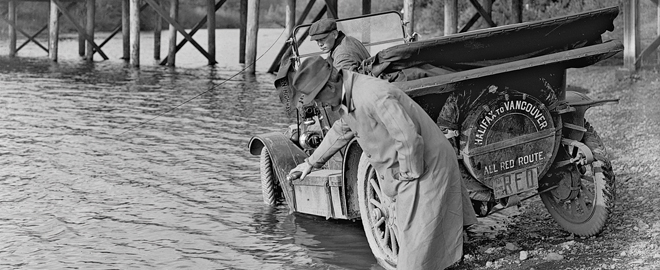Canada’s first coast-to-coast road trip was no joyride
A snob, a chauffeur, four wheels and a mission: Halifax to Vancouver — or bust
Share

Thomas Wilby knew exactly what he was doing 100 years ago when he proposed the first coast-to-coast road trip across Canada. The previous year, the British journalist had driven from New York to San Diego and back, and knew there was money and glory to be found in writing and lecturing about the experience. So in 1912, he approached the REO auto company of St. Catharines, Ont., with a similar request: give him a car and a driver and he would travel from Halifax to Vancouver within Canada to promote four-wheeled travel and—he hoped—the reliability of the REO. As well as providing a new car and paying all the bills, the company also supplied him with its head mechanic, a capable young American, Jack Haney, to be the driver.
Therein lay the problem. Wilby was a 45-year-old snob who had little time for Americans who would not defer to him. Haney, 23, thought he’d be assisting a fellow gearhead; that illusion vapourized when the two first met in Halifax, and Wilby insisted on being called “sir.”
The two dipped the car’s wheels in the Atlantic Ocean on Aug. 27, 1912, and headed west with just a few maps and Wilby in the back seat, directing the way. The single-track country roads were soaked with rain; mud got everywhere. Canada had only one paved road, built that year between Toronto and Hamilton, and the route would take them nowhere near it. (The Trans-Canada highway, which turns 50 this summer, had yet to be even contemplated.)
The roads were wet pretty much all through the Maritimes, delivering a slippery challenge. Near the end of the fourth day, driving toward Grand Falls, N.B., the road turned to corduroy—no more than felled tree stumps laid side by side through a swamp like railway ties. After crossing the logs for eight kilometres, the REO ran out of gas on a hill. Haney was forced to blow into the gas line, forcing the last drops of fuel into the engine. “The unfortunate chauffeur did not burst his cheeks or succumb to asphyxia,” Wilby wrote in his subsequent book about the journey, “for it fell to his lot to blow into the petrol tank every few moments of the remaining journey.”
That was one of only four references to “the chauffeur” in the entire 290 pages of A Motor Car Tour Through Canada, published in 1914, and Haney was never referred to by name. Nor was the make of the car ever mentioned; Wilby was still angry at REO for supplying an American to be his driver. (“To make matters worse, I was compelled to inquire my way,” he wrote. “Pronunciaton of names was out of the question, and the chauffeur was no help since he knew only American English.”) For his part, Haney plugged along and did all the work, digging and winching the car out of bogs, recording his own thoughts in a diary: “I am heartily sick of my companion and will be mighty glad when the trip is over,” he wrote in Ottawa.
The entire drive took 52 days, but despite Wilby’s best intentions it did not qualify as the first cross-Canada road trip because there just weren’t enough roads in Canada to cover the country. Most highways headed south to link the provinces to U.S. markets, and the swamps and Shield rock of northern Ontario were a costly challenge to road construction, as were the Rocky Mountains. In North Bay, Ont., the adventurers were forced to load the car onto a train bound for Sudbury, then onto a schooner across Lake Superior to Port Arthur (now Thunder Bay), and then once again onto a train to Selkirk, near Winnipeg. They navigated the sticky gumbo of the Prairies, and even drove along a short stretch of railway in British Columbia, ready to jump if a train appeared, but were finally forced to detour around B.C.’s highest peaks along a short series of roads in Washington state.
Wilby lectured in almost every town on the importance of improving the country’s roads, while Haney worked into the night to keep the car running reliably. They reached Vancouver on Oct. 14, where the Vancouver Sun reported that “no tour by motor car has caused more widespread interest. The difficulties attendant upon the expedition were almost incalculable.” Wilby was treated as a hero while Haney stayed in the background; they continued on to Victoria and then returned home on separate trains.
Mark Richardson is driving across Canada this summer to mark the 50th anniversary of the opening of the Trans-Canada Highway. He leaves St. John’s on June 4 and will arrive at Victoria in August. Follow his daily blog at macleans.ca, or on Twitter @WheelsMark.